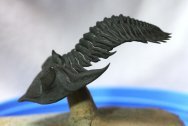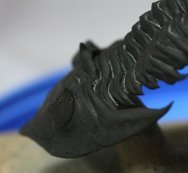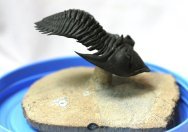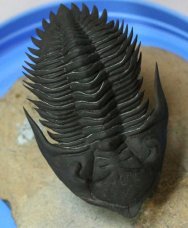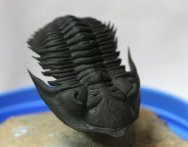Metacanthina issoumourensis
Trilobite Order Phacopida, Superfamily Acastoidea, Family Acastidae, Subfamily Asteropyginae
Geologic Time: Middle Devonian
Size: Trilobite is 58 mm
Fossil Site: Aatchana, Morocco
 Description:
This member of the trilobite Order Phacopida, Subfamily Asteropyginae
is nothing short of an exquisite fossil specimen. It’s not
the species rarity, because Metacanthina issoumourensis is fairly
common. It’s not its life pose that, while time consuming
and expensive, has become pretty common also. What makes
it exquisite is the very fine preservation, and the also very fine
and careful
preparation. Description:
This member of the trilobite Order Phacopida, Subfamily Asteropyginae
is nothing short of an exquisite fossil specimen. It’s not
the species rarity, because Metacanthina issoumourensis is fairly
common. It’s not its life pose that, while time consuming
and expensive, has become pretty common also. What makes
it exquisite is the very fine preservation, and the also very fine
and careful
preparation.
Metacanthina
issoumourensis was previously called Asteropyge or Kayserops,
and you will
see those names still used. The Phacopids appear in the fossil
record in the lower Ordovician. Phacopids of The schizochroal eye was unique in that each lens is biconvex and was made of two calcite elements having different refractive indices. These were separated by an aspherical surface giving an overall effect of correcting spherical aberration. Ostensibly, whether predator or prey, it could see them better, a huge advantage in the trilobite arms race. The development of the schizochroal eyes is but one example in nature of so called post-displacement paedomorphosis, whereby selective pressures, because survival is benefited, results in the retaining of traits previously only existing in juvenile members of a species. The Phacopina thus constitute a notable example that Life remembers its history, with that memory embedded in the genomes. This evolutionary innovation has never been repeated among the Arthropods. Also see: The Evolutionary Arms Race - Examples Among Trilobites Moroccan Trilobites |

